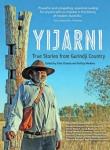'This story, in which a white man travelling up the Victoria River is murdered by several local Aboriginal men, clearly correlates to the murder of Patrick O'Neill (also called 'Paddy the Lasher). Accused of the murder was a Gurindji man, reportedly called Wallagoolah (who was probably named after the place Warlakula, (see Chapter 3). Several details of the dialogue Danbayarri reports correspond with witness statements recorded in a newspaper report in December 1896, for example where two of the men were hesitant to murder the man, but one of them was convinced it was necessary and committed the murder himself. Danbayarri describes a farcical, almost comical, scene where the kartiya mocks a ngumpin over his hunting catch, a dead goanna, takes it from him and slaps one of them with it. Both Danbayarri and the newspaper accounts describe the body being thrown into the water. The witnesses in the trial, a man named Caralagoolah and a woman named Bungalla Kitty, were not eyewitnesses to the event, but were from the same Aboriginal clan and claim to have overheard one of the defendants, Jaydeadda, telling of how he had committed the so-called 'killing'.' (Introduction)



